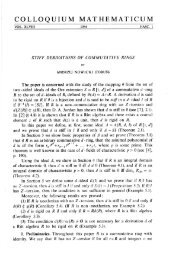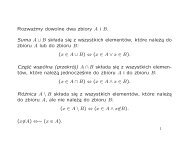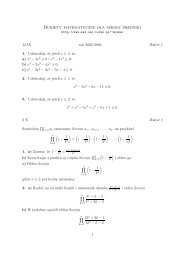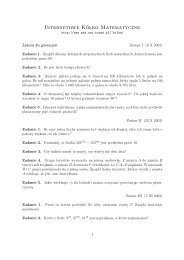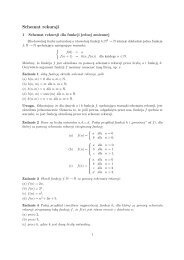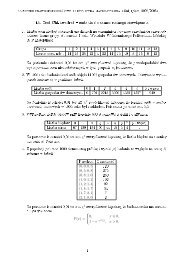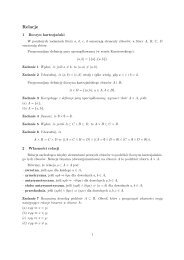Derivations of Ore extensions of the polynomial ring in one variable
Derivations of Ore extensions of the polynomial ring in one variable
Derivations of Ore extensions of the polynomial ring in one variable
You also want an ePaper? Increase the reach of your titles
YUMPU automatically turns print PDFs into web optimized ePapers that Google loves.
Consider <strong>the</strong> derivation δ 1 = δ − a n e n . Observe that deg t δ 1 (x) < n (Proposition 3.1).So, by <strong>in</strong>duction, δ 1 = b 0 e 0 + · · · + b n−1 e n−1 for some b 0 , . . . , b n−1 ∈ k[x]. Therefore,δ = δ 1 + a n e n = b 0 e 0 + · · · + b n−1 e n−1 + a n e n is a l<strong>in</strong>ear comb<strong>in</strong>ation <strong>of</strong> e 0 , . . . , e n overk[x]. □In <strong>the</strong> next <strong>the</strong>orem, which is true for arbitrary k-doma<strong>in</strong> R (even if k is <strong>of</strong> positivecharacteristic), we show when a derivation δ : k[x] → k[x][t, d] has an extension to aderivation <strong>of</strong> k[x][t, d].Theorem 3.3. Let d be a derivation <strong>of</strong> a commutative k-doma<strong>in</strong> R, and let A = R[t, d].Assume that δ : R → A is a derivation and f ∈ A. Then <strong>the</strong> follow<strong>in</strong>g conditions areequivalent.(1) There exists a unique derivation D : A → A such that D|R = δ and D(t) = f.(2) [f, r] + [t, δ(r)] = δ(d(r)), for every r ∈ R.Pro<strong>of</strong>. (1) ⇒ (2). Let D : A → A be a derivation such that D|R = δ and D(t) = f.Let r ∈ R. S<strong>in</strong>ce [t, r] = d(r), we haveδ(d(r)) = D(d(r)) = D([t, r]) = [D(t), r] + [t, D(r)] = [f, r] + [t, δ(r)].(2) ⇒ (1). We will def<strong>in</strong>e a function D : R[t, d] → R[t, d]. If w ∈ R[t, d], <strong>the</strong>n wedef<strong>in</strong>e <strong>the</strong> element D(w), us<strong>in</strong>g an <strong>in</strong>duction with respect to deg w, <strong>in</strong> <strong>the</strong> follow<strong>in</strong>g way.If w = 0, <strong>the</strong>n we put D(w) = 0. If deg w = 0, <strong>the</strong>n w ∈ R and we put D(w) = δ(w).Let deg w = n + 1, where n 0, and assume that we know D(u) for all u ∈ R[t, d] withdeg u n. Then w is <strong>of</strong> <strong>the</strong> form w = ut + a, where a ∈ R, u ∈ R[t, d], deg u = n. Wedef<strong>in</strong>eD(w) := δ(a) + D(u)t + uf.So, we have a function D : R[t, d] → R[t, d]. It is clear that this function is k-l<strong>in</strong>ear. Nowwe will show that D(uv) = D(u)v + uD(v) for all u, v ∈ R[t, d]. We use an <strong>in</strong>duction withrespect to deg(uv). Note that, s<strong>in</strong>ce R is a doma<strong>in</strong>, deg(uv) = deg(u) + deg(v).If u = 0 or v = 0, <strong>the</strong>n <strong>of</strong> course D(uv) = D(u)v + uD(v). Assume now that u ≠ 0and v ≠ 0. If deg(uv) = 0, <strong>the</strong>n uv ∈ R and <strong>the</strong>n u, v ∈ R, so D(uv) = δ(uv) =δ(u)v + uδ(v) = D(u)v + uD(v).Let deg(uv) = 1. Then (deg(u) = 1 and deg v = 0) or (deg(u) = 0 and deg v = 1).Assume that u = a + bt, v = c, where a, b, c ∈ R. Then we have:D(uv) − D(u)v − uD(v) = D((a + bt)c) − D(a + bt)c − (a + bt)D(c)= D(ac + bct + bd(c)) − D(a + bt)c − (a + bt)D(c)= δ(ac + bd(c)) + δ(bc)t + bcf − (δ(a) + δ(b)t + bf)c − (a + bt)δ(c)= δ(a)c + aδ(c) + δ(b)d(c) + bδ(d(c)) + δ(b)ct + bδ(c)t + bcf−δ(a)c − δ(b)ct − δ(b)d(c) − bfc − aδ(c) − bδ(c)t − bd(δ(c))= b · (δ(d(c)) + cf − fc − d(δ(c))) = b · (δ(d(c)) − [f, c] − [t, δ(c)])= b · 0 = 0,4
so <strong>in</strong> this case, D(uv) = D(u)v + uD(v). Now let u = c and v = a + bt, where a, b, c ∈ R.ThenD(uv) − D(u)v − uD(v) = D(ca + cbt) − δ(c)(a + bt) − cD(a + bt)= δ(ca) + δ(cb)t + cbf − δ(c)a − δ(c)bt − cδ(a) − cδ(b)t − cbf= (δ(ca) − δ(c)a − cδ(a)) + (δ(cb) − δ(c)b − cδ(b))t= (δ(ca) − δ(ca)) + (δ(cb) − δ(cb))t= 0 + 0t = 0.Hence, we proved that if deg(uv) 1, <strong>the</strong>n D(uv) = D(u)v + uD(v).Let deg(uv) = n + 1, where n 1, and assume that our statement is true for allproducts <strong>of</strong> degrees n.Case 1. Assume that deg v = 0. Let v = b ∈ R. Then deg u = n + 1. Let u = a + wt,where a ∈ R, w ∈ R[t, d], deg w n. Then uv = (a + wt)b = ab + wd(b) + wbt and henceD(uv) = δ(ab) + D(wd(b)) + D(wb)t + wbf,D(u)v + uD(v) = (δ(a) + D(w)t + wf)b + (a + wt)δ(b).Observe that deg wd(b) n and deg wb n. Hence, by <strong>in</strong>duction, D(uv)−D(u)v−uD(v)= δ(ab) + D(wd(b)) + D(wb)t + wbf − δ(a)b − D(w)tb − wfb − aδ(b) − wtδ(b)= D(w)d(b) + wD(d(b)) + D(w)bt + wD(b)t + wbf − D(w)tb − wfb − wtδ(b)= wD(d(b)) + wD(b)t + wbf − wfb − wtδ(b)= w(D(d(b)) + D(b)t + bD(t) − D(t)b − tδ(b))= w(D(d(b)) + D(bt) − D(tb)) = wD(d(b) + bt − tb) = wD(0) = 0.Case 2. Assume that deg v 1. Then deg u n and <strong>the</strong>n v = b + wt, where b ∈ R,w ∈ R[t, d], w ≠ 0, deg w < deg v. So we have uv = ub + uwt, and deg(ub) n,deg(uw) n. Hence, by <strong>in</strong>duction, we have:D(uv) − D(u)v − uD(v) = D(ub + uwt) − D(u)(b + wt) − uD(b + wt)= D(ub) + D(uw)t + uwD(t) − D(u)b − D(u)wt − uD(b) − uD(w)t − uwD(t)= D(u)wt + uD(w)t − D(u)wt − uD(w)t = 0.Therefore, we proved by <strong>in</strong>duction that <strong>the</strong> mapp<strong>in</strong>g D is really a derivation <strong>of</strong> R[t, d].Note that D|R = δ and D(t) = f and it is clear that such D is unique. □Lemma 3.4. Let d : R → R be a derivation <strong>of</strong> a commutative k-algebra R, and letA = R[t, d] be <strong>the</strong> <strong>Ore</strong> extension. Assume that δ : R → A is a derivation and f ∈ A.Then <strong>the</strong> set M := {r ∈ R; [f, r] + [t, δ(r)] = δ(d(r))} is a k-subalgebra <strong>of</strong> R.Pro<strong>of</strong>. It is clear that 1 ∈ M and that if a, b ∈ M, <strong>the</strong>n a + b ∈ M. Now leta, b ∈ M. We will show that ab ∈ M. We have:[f, ab] + [t, δ(ab)] = [f, a]b + a[f, b] + [t, δ(a)b + aδ(b)]= [f, a]b + a[f, b] + [t, δ(a)]b + δ(a)[t, b] + [t, a]δ(b) + a[t, δ(b)]= ([f, a] + [t, δ(a)])b + a([f, b] + [t, δ(b)]) + δ(a)[t, b] + [t, a]δ(b)= δ(d(a))b + aδ(d(b)) + δ(a)d(b) + d(a)δ(b) = δ(d(a)b + ad(b))= δ(d(ab)).5
Hence, ab ∈ M. □As a consequence <strong>of</strong> Lemma 3.4 and Theorem 3.3 we obta<strong>in</strong>Corollary 3.5. Let R be a commutative k-doma<strong>in</strong> generated over k by a subset S ⊆ R.Let d : R → R be a derivation and let A = R[t, d] be <strong>the</strong> <strong>Ore</strong> extension. Assume thatδ : R → A is a derivation and f ∈ A. Then <strong>the</strong> follow<strong>in</strong>g conditions are equivalent.(1) There exists a unique derivation D : A → A such that D|R = δ and D(t) = f.(2) [f, s] + [t, δ(s)] = δ(d(s)), for every s ∈ S. □Corollary 3.6. Let R = k[x] and let A = R[t, d] be an <strong>Ore</strong> extension. Assume thatδ : R → A is a derivation and f ∈ A. Then <strong>the</strong>re exists a unique derivation D : A → Asuch that D|R = δ and D(t) = f if and only if(∗) [f, x] + [t, δ(x)] = δ(d(x)). □4 Scalar <strong>in</strong>ner derivationsIf f ∈ R[t, d], <strong>the</strong>n we will denote by W f <strong>the</strong> <strong>in</strong>ner derivation [f, ]. We will say thatW f is a scalar <strong>in</strong>ner derivation if all <strong>the</strong> coefficients <strong>of</strong> f belong to k, that is, if f ∈ k[t].S<strong>in</strong>ce W f = W f+c for any c ∈ k, we may always assume that f is without constant term(i.e., f(0) = 0). Note that if W f is a scalar <strong>in</strong>ner derivation, <strong>the</strong>n W f (t) = 0. Thefollow<strong>in</strong>g proposition says that if R = k[x], <strong>the</strong>n <strong>the</strong> converse <strong>of</strong> this fact is also true.Proposition 4.1. Let d be a derivation <strong>of</strong> R = k[x] with ϕ = d(x) ≠ 0, and let D be aderivation <strong>of</strong> R[t, d]. If D(t) = 0, <strong>the</strong>n <strong>the</strong>re exists a unique <strong>polynomial</strong> f ∈ k[t] such thatD = W f and f(0) = 0.Pro<strong>of</strong>. Assume that D(t) = 0 and let δ : R → R[t, d] be <strong>the</strong> restriction <strong>of</strong> D toR. Us<strong>in</strong>g Proposition 3.2 we have an equality <strong>of</strong> <strong>the</strong> form δ = a n e n + · · · + a 1 e 1 + a 0 e 0 ,where n 0 and a n , . . . , a 0 ∈ k[x]. We will show, by an <strong>in</strong>duction on n, that <strong>the</strong>re existsa <strong>polynomial</strong> f ∈ k[t] such that D = W f and f(0) = 0. S<strong>in</strong>ce <strong>the</strong> case D = 0 is obvious,we may assume that a n ≠ 0.Let n = 0. Then δ(x) = a 0 and, by (∗), [0, x] + [t, δ(x)] = δ(ϕ), so a 0 ϕ ′ = d(a 0 ) =[t, a 0 ] = [t, δ(x)] = δ(ϕ) = ϕ ′ a 0 , that is, a 0 ϕ ′ = ϕ ′ a 0 . This implies that ( a 0ϕ) ′ = 0, soa 0 = c 1 ϕ for some c 1 ∈ k, and we have δ = a 0 e 0 = c 1 ϕe 0 = c 1 ϕ 1 [t, ] = [c f 1t, ].Let f = c 1 t. Then f ∈ k[t], f(0) = 0 and D = W f (because D(t) = 0 = W f (t) andD(x) = δ(x) = [c 1 t, x] = W f (x)).Assume now that n 1 and that for all numbers smaller <strong>the</strong>n n our statement <strong>in</strong>true. Let δ(x) = a n e n + · · · + a 0 e 0 , with a n ≠ 0 and a 0 , . . . , a n ∈ k[x]. Then, by (∗),[0, x] + [t, δ(x)] = δ(ϕ). Compa<strong>r<strong>in</strong>g</strong> <strong>in</strong> this equality <strong>the</strong> coefficients with respect to t n weget <strong>the</strong> equality a ′ nϕ = a n ϕ ′ , which implies that a n = p n+1 ϕ for some nonzero p n+1 ∈ k.Now we have:1a n e n = p n+1 ϕe n = p n+1 ϕ(n + 1)ϕ [tn+1 , ] = [c n+1 t n=1 , ],6
where c n+1 = 1n+1 p n+1 ∈ k {0}.Consider <strong>the</strong> derivation D 1 = D − [c n+1 t n+1 , ]. Observe that D 1 (t) = 0 and D 1 |R =a n−1 e n−1 + · · · + a 0 e 0 . So, by <strong>in</strong>duction, D 1 = [h, ] for some h ∈ k[t] with h(0) = 0.Hence D = D 1 + [c n+1 t n+1 , ] = W h + [c n+1 t n+1 , ] = W f , where f = c n+1 t n+1 + h ∈ k[t].This completes <strong>the</strong> pro<strong>of</strong> <strong>of</strong> existence <strong>of</strong> f. We will show yet, that such a <strong>polynomial</strong>f is unique. Suppose that f, g ∈ k[t], W f = W g and f(0) = g(0) = 0. Then W f−g = 0.Put h := f − g = c p t p + · · · + c 1 t 1 and suppose that h ≠ 0. Then a p ≠ 0, p 1, and wehave0 = W h (x) = [c p t p + · · · + c 1 t + c 0 , x] = pc p ϕt p−1 + h p−2 ,for some h p−2 ∈ k[x][x, d] with deg t h p−2 p − 2. We have a contradiction: 0 = pc p ϕ ≠ 0.Hence, h = 0, that is, f = g. □5 <strong>Derivations</strong> ∆ aLet R be a k-doma<strong>in</strong>, and let d : R → R be a derivation. If a ∈ R, <strong>the</strong>n Theorem 3.3implies that <strong>the</strong>re exists a unique derivation ∆ a : R[t, d] → R[t, d] such that∆ a (t) = a, ∆ a (r) = 0 for every r ∈ R.In particular, ∆ a (t) = a, ∆ a (t 2 ) = 2at + d(a), ∆ a (t 3 ) = 3at 2 + 3d(a)t + d 2 (a) and∆ a (t 4 ) = 4at 3 + 6d(a)t 2 + 4d 2 (a)t + d 3 (a).Proposition 5.1. The derivation ∆ a is <strong>in</strong>ner if and only if a ∈ d(R).Pro<strong>of</strong>. Assume that ∆ a = [f, ], for some f = a n t n + · · · + a 1 t 1 + a 0 ∈ R[t, d]. Thena = ∆ a (t) = [f, t] = −d(a n )t n − · · · − d(a 1 )t − d(a 0 ). In particular, a = d(−a 0 ) ∈ d(R).Assume now that a = d(b) for some b ∈ R and consider <strong>the</strong> <strong>in</strong>ner derivation D =[−b, ]. We have here: ∆ a (r) = D(a) = 0 for all r ∈ R, and D(t) = [−b, t] = [t, b] =d(b) = a = ∆ a (t). Hence, ∆ a = [−b, ] is an <strong>in</strong>ner derivation <strong>of</strong> R[t, d]. □As a consequence <strong>of</strong> this proposition we obta<strong>in</strong>Corollary 5.2. Let R be a k-doma<strong>in</strong>. If every derivation <strong>of</strong> R[t, d] is <strong>in</strong>ner, <strong>the</strong>n d issurjective. □Proposition 5.3. If D is a derivation <strong>of</strong> k[x][t, d] such that D(t) = a ∈ k[x], <strong>the</strong>nD = W + ∆ a , where W is a scalar <strong>in</strong>ner derivation.Pro<strong>of</strong>. Let W = D −∆ a . S<strong>in</strong>ce W (t) = 0, Proposition 4.1 implies that W is a scalar<strong>in</strong>ner derivation. □Proposition 5.4. Let d be a derivation <strong>of</strong> R = k[x] with ϕ = d(x) ≠ 0. If a ∈ R, <strong>the</strong>n∆ a = W + ∆ r , where W is an <strong>in</strong>ner derivation <strong>of</strong> R[t, d], and r ∈ k[x] is <strong>the</strong> rema<strong>in</strong>der<strong>of</strong> a <strong>in</strong> <strong>the</strong> divisibility by ϕ.7
Pro<strong>of</strong>. Let a = bϕ + r, b, r ∈ k[x], deg r < deg ϕ. Then ∆ a = ∆ bϕ+r = ∆ bϕ + ∆ rand, by Proposition 5.1, <strong>the</strong> derivation ∆ bϕ is <strong>in</strong>ner. □Proposition 5.5. Let R = k[x], d : R → R be a derivation with ϕ = d(x) ≠ 0. Thenfor every a ∈ R <strong>the</strong>re exists a unique derivation D a <strong>of</strong> R[t, d] such that D a (t) = a andD a (x) = ϕ. The derivation D a is equal to [t, ] + ∆ a . The derivation D a is <strong>in</strong>ner if andonly if a is divisible by ϕ.Pro<strong>of</strong>. Let D = [t, ] + ∆ a . Then D(x) = [t, x] + ∆ a (x) = d(x) + 0 = ϕ andD(t) = [t, t] + ∆ a (t) = 0 + a = a. This implies that <strong>the</strong> derivation D a exists and thatD a = D. S<strong>in</strong>ce [t, ] is <strong>in</strong>ner, <strong>the</strong> derivation D a is <strong>in</strong>ner if and only if ∆ a is <strong>in</strong>ner. Thelast statement is equivalent (by Proposition 5.1) to <strong>the</strong> divisibility <strong>of</strong> a by ϕ. □Let R be a k-doma<strong>in</strong>. Note that <strong>the</strong> <strong>in</strong>ner derivation D 0 = [t, ] : R[t, d] → R[t, d]is an extension <strong>of</strong> <strong>the</strong> derivation d such that D 0 (t) = 0. If d ≠ 0, <strong>the</strong>n every derivationD : R[t, d] → R[t, d], such that D|R = d, satisfies <strong>the</strong> condition: D(t) ∈ R. The same istrue if D|R = δ, where δ : R → R is a derivation such that δd = dδ.Consider <strong>the</strong> derivation ∆ = ∆ 1 . This is a unique derivation <strong>of</strong> R[t, d] such that∆(t) = 1 and ∆(r) = 0 for all r ∈ R. In this case we have:∆(a n t n + · · · + a 1 t 1 + a 0 ) = na n t n−1 + (n − 1)a n−1 t n−2 + · · · + 2a 2 t + a 1 .So ∆ is equal to usual partial derivative ∂ ∂t<strong>in</strong>ner if and only if 1 ∈ d(R).<strong>of</strong> R[t, d]. Note that (by Proposition 5.1) ∆ is6 Polynomials <strong>of</strong> <strong>the</strong> form D(t)Proposition 6.1. Let d be a nonzero derivation <strong>of</strong> a k-doma<strong>in</strong> R. Assume that D :R[t, d] → R[t, d] is a derivation such that D(t) = u n t n + · · · + u 1 t 1 + u 0 , where n 0 andu 0 , . . . , u n ∈ R. If D is <strong>in</strong>ner, <strong>the</strong>n u 0 , . . . , u n ∈ d(R).Pro<strong>of</strong>. Assume that D = [f, ], where −f = a m t m + · · · + a 1 t + a 0 ∈ R[t, d]. Thenu n t n + · · · + u 1 t 1 + u 0 = D(t) = [f, t] = [t, −f] = d(a m )t m + · · · + d(a 1 )t + d(a 0 ), Thus, wehave u 0 = d(a 0 ) ∈ d(R), u 1 = d(a 1 ) ∈ d(R) and so on. □Proposition 6.2. Let R = k[x] and let d : R → R be a nonzero derivation with d(x) =ϕ ≠ 0. Let D : R[t, d] → R[t, d] be a derivation such that D(t) = u n t n + · · · + u 1 t + u 0 ,where n 0 and u 0 , . . . , u n ∈ R. Then D is <strong>in</strong>ner if and only if u 0 , . . . , u n ∈ d(R).Pro<strong>of</strong>. Assume that u 0 , . . . , u n ∈ d(R). Let u 0 = d(b 0 ), . . . , u n = d(b n ), for someb 0 , . . . , b n ∈ R. Let f = −b n t n − b n−1 t n−1 − · · · − b a t − b 0 and let D 1 = D − [f, ]. ThenD 1 is a derivation <strong>of</strong> R[t, d] such that D(t) = 0. This derivation is <strong>in</strong>ner (by Proposition4.1). Hence <strong>the</strong> derivation D = D 1 + [f, ] is <strong>in</strong>ner. The opposite implication followsfrom Proposition 6.1. □8
Corollary 6.3. Let R = k[x] and let d : R → R be a nonzero derivation with d(x) = ϕ ≠0. Assume that D : R[t, d] → R[t, d] is a derivation such that D(t) = u n t n +· · ·+u 1 t+u 0 ,where n 0 and u 0 , . . . , u n ∈ R. Then D = W + D 1 , where W is an <strong>in</strong>ner derivation <strong>of</strong>R[t, d] and D 1 is a derivation <strong>of</strong> R[t, d] such that D 1 (t) = r n t n + · · · + r 1 t 1 + r 0 , whereeach r i (for i = 0, 1, . . . , n) is <strong>the</strong> rema<strong>in</strong>der <strong>in</strong> <strong>the</strong> divisibility <strong>of</strong> u i by ϕ. □Pro<strong>of</strong>. Let u i = a i ϕ + r i , a i , r i ∈ k[x], deg r i < deg ϕ, for i = 0, 1, . . . , n. Note thateach a i ϕ belongs to d(R). Put a i ϕ = d(b i ) for i = 0, . . . , n, and let g = −b n t n − · · · −b 1 t 1 − b 0 . Consider <strong>the</strong> derivation D 1 = D − [g, ]. Then D 1 (t) = r n t n + · · · + r 1 t 1 + r 0and we have D = [g, ] + D 1 . □Note also <strong>the</strong> follow<strong>in</strong>gProposition 6.4. Let d be a nonzero derivation <strong>of</strong> R = k[x], and let D be a derivation<strong>of</strong> R[t, d]. If D(x) = 0, <strong>the</strong>n D(t) ∈ R. If D(x) ≠ 0, <strong>the</strong>n deg t D(t) 1 + deg t D(x), andmoreover, <strong>the</strong>re exists an <strong>in</strong>ner derivation W <strong>of</strong> R[t, d] such that <strong>the</strong> D 1 (t) = D(t) anddeg t D 1 (t) = 1 + deg t D 1 (x), where D 1 := D + W .Pro<strong>of</strong>. Let D(t) = u n t n + · · · + u 0 , D(x) = a m t m + · · · + a 0 , where all <strong>the</strong> coefficientsu 0 , . . . , u n , a 0 , . . . , a m belong to R.Assume that D(x) = 0 and suppose that n 1 and u n ≠ 0. Then (∗) implies that[D(t), x] = 0. But [D(t), x] = nu n d(x)t n−1 + h, where h ∈ R[t, d] and deg t h < n − 1. Sowe have a contradiction: 0 = nu n d(x) ≠ 0. Thus, if D(x) = 0, <strong>the</strong>n D(t) = u 0 ∈ R.Assume now that D(x) ≠ 0. Then m 0, a m ≠ 0 and, by (∗), nu n d(x)t n−1 + h +d(a m )t m + · · · d(a 0 ) = ϕ ′ a m t m + v, where ϕ = d(x), h, v ∈ R[t, d], deg t h < n − 2 anddeg t v < m. If n − 1 > m, <strong>the</strong>n nu n d(x) = 0, but this is a contradiction. So, n − 1 m,that is, deg t D(t) 1 + deg t D(x).Assume now that( )n − 1 < m. Then, by <strong>the</strong> above equality, d(a m ) = ϕ ′ a m . Hence,′a ′ mϕ = ϕ ′ aa m so, mϕ= 0 and this implies that a m = cϕ, for some c ∈ k. Let W =[c 1m+1 tm+1 , ], and let D 1 = D − W . Then D 1 (t) = D(t) and deg t D 1 (x) = m 1 < m. Ifaga<strong>in</strong> n−1 < m 1 , <strong>the</strong>n we repeat <strong>the</strong> same procedure for <strong>the</strong> derivation D 1 . Repeat<strong>in</strong>g thisargument several times we obta<strong>in</strong> an <strong>in</strong>ner derivation W <strong>of</strong> R[t, d] and a new derivationD 1 = W + d hav<strong>in</strong>g <strong>the</strong> required properties. □7 On some differential equationIn this section we consider a differential equation <strong>of</strong> <strong>the</strong> formuϕ = aϕ ′ − a ′ ϕ,where ϕ is a nonzero <strong>polynomial</strong> from k[x], and u, a ∈ k[x].Lemma 7.1. Let ϕ, u, a be as above. If deg u < deg ϕ and gcd(ϕ, ϕ ′ ) = 1, <strong>the</strong>n u = 0.9
and, if m > s, <strong>the</strong>n I(f − g ′ ) = (m − s)x s−1 .Now let a ∈ k[x] be such that uϕ = aϕ ′ − a ′ ϕ. Then <strong>of</strong> course a ≠ 0 and ugψ =afψ − a ′ gψ, so ug = af − a ′ g. This implies that g divides a (because gcd(f, g) = 1). Leta = gb for some b ∈ k[x] {0}. Then ug = bgf − b ′ g 2 − bg ′ g, so u = bf − b ′ g − bg ′ , that is,(1) u = b(f − g ′ ) − b ′ g.Observe that ψ ·(f −g ′ ) = ψ ′ g. In fact: ψ ·(f −g ′ )−ψ ′ g = ψf −(ψg ′ +ψ ′ g) = ϕ ′ −(ψg) ′ =ϕ ′ − ϕ ′ = 0. This means, that if <strong>the</strong>re exists a <strong>polynomial</strong> b satisfy<strong>in</strong>g <strong>the</strong> equality (1),<strong>the</strong>n every <strong>polynomial</strong> <strong>of</strong> <strong>the</strong> form b + cψ, where c ∈ k, also satisfies this equality. As aconsequence <strong>of</strong> this fact, we may assume that b ∈ k[x] is a nonzero <strong>polynomial</strong> satisfy<strong>in</strong>g(1) and <strong>the</strong> coefficient <strong>of</strong> b with respect to x m−s is equal to zero.We must prove that deg u s − 1. Suppose that deg u < s − 1. Let u = u s−2 x s−2 +· · · + u 0 , u 0 , . . . , u s−2 ∈ k, u i ≠ 0 for some i ∈ {0, 1, . . . , s − 2}. Let b = b p x p + · · · + b 0 ,b 0 , . . . , b p ∈ k, p 0 and b p ≠ 0. Then <strong>the</strong> equality (1) is <strong>of</strong> <strong>the</strong> form:u s−2 x s−2 + · · · + u 0 = (b p x p + · · · )((m − s)x s−1 + · · · ) − (pb p x p−1 + · · · )(x s + · · · ).S<strong>in</strong>ce p + s − 1 s − 1 > s − 2, we have ((m − s) − p)b p = 0. But b p ≠ 0, so p = (m − s).However, by our assumption, <strong>the</strong> coefficient b m−s is equal to zero. Thus, we have acontradiction: 0 ≠ b p = b m−s = 0. Therefore, deg u s − 1. □Remark 7.4. If f, g, ϕ, ψ are as <strong>in</strong>(<strong>the</strong>)pro<strong>of</strong> <strong>of</strong> Lemma 7.3, <strong>the</strong>n ψ 2 divides ϕψ ′ and′ϕψ ′= f − g ′ . In fact, f − g ′ = ϕ′− ϕψ 2 ψ ψ =ϕ ′− 1 (ϕ ′ ψ − ϕψ ′ ) = ϕ′ ψ−ϕ ′ ψ+ϕψ ′= ϕψ′ . □ψ ψ 2 ψ 2ψ 2Proposition 7.5. Let 0 ≠ ϕ ∈ k[x], deg ϕ 1. The follow<strong>in</strong>g two properties are equivalent.(1) There exists a <strong>polynomial</strong> a ∈ k[x] such that ϕ = aϕ ′ − a ′ ϕ.(2) ϕ = c(x − λ) m , for some λ, c ∈ k, c ≠ 0 and m 2.Pro<strong>of</strong>. (1) ⇒ (2). Assume that ϕ = aϕ ′ − a ′ ϕ for some a ∈ k[x]. Let m = deg ϕ andlet s be as <strong>in</strong> Lemma 7.3. Us<strong>in</strong>g Lemma 7.1 for u = 1, we obta<strong>in</strong> that m 2. Moreover,Lemma 7.3 implies that s = 1. Hence, ϕ = c(x − λ) m , 0 ≠ c ∈ k, λ ∈ k and m 2.(1) ⇒ (2) Assume that ϕ is <strong>of</strong> <strong>the</strong> form (2), and take a = 1 (x − λ). Then:m−1ϕ − aϕ ′ + a ′ ϕ = c(x − λ) m − mc(x − λ) m−1 11(x − λ) + c(x − λ)mm−1 m−1= c(x − λ) m ( 1 − mm−1 + 1m−1)= c(x − λ) m 0 = 0.Note that every <strong>polynomial</strong> a ∈ k[x] <strong>of</strong> <strong>the</strong> form a = 1satisfies <strong>the</strong> equality ϕ = aϕ ′ − a ′ ϕ. □m−1(x − λ) + αϕ, with α ∈ k, alsoLemma 7.6. Let d be a nonzero derivation <strong>of</strong> R = k[x] and let ϕ = d(x) ≠ 0. Letu ∈ k[x]{0} and assume that <strong>the</strong>re exists a <strong>polynomial</strong> a ∈ k[x] such that uϕ = aϕ ′ −a ′ ϕ.For any n 1 consider <strong>the</strong> <strong>in</strong>ner derivation D n = [ a ϕ tn , ] <strong>of</strong> <strong>the</strong> <strong>r<strong>in</strong>g</strong> k(x)[t, d]. Then:(1) D n (R[t, d]) ⊆ R[t, d].(2) Denote by D n <strong>the</strong> restriction <strong>of</strong> D n to R[t, d]. Then D n is a unique derivation <strong>of</strong>R[t, d] such that D n (t) = ut n , D n (x) = nae n−1 (x).11
Pro<strong>of</strong>. We have: D n (t) = [ a ϕ tn , t] = −d( a ϕ )tn = − a′ ϕ−aϕ ′ϕt n = uϕ ϕt n = ut n andϕ 2ϕ 2D n (x) = [ a ϕ tn , x] = a ϕ [tn , x] = na 1nϕ [tn , x] = nae n−1 (x). This implies (1) and (2). □Theorem 7.7. Let R = k[x] and let d : R → R be a nonzero derivation with d(x) = ϕ ≠ 0.Let u ∈ k[x] {0}. The follow<strong>in</strong>g properties are equivalent.(1) There exists a ∈ k[X] such that uϕ = aϕ ′ − a ′ ϕ.(2) There exists a derivation D 1 <strong>of</strong> R[t, d] such that D 1 (u) = ut.(3) There exist n 1 and a derivation D n <strong>of</strong> R[t, d] such that D n (t) = ut n .(4) For every n 1 <strong>the</strong>re exists a derivation D n <strong>of</strong> R[t, d] such that D n (t) = ut n .Pro<strong>of</strong>. The implication (1) ⇒ (4) follows from Lemma 7.6. The implications (4) ⇒(2) and (2) ⇒ (3) are obvious. Now we will prove <strong>the</strong> implication (3) ⇒ (1).Assume that D n : R[t, d] → R[t, d] is a derivation such that D n (t) = ut n , where n 1is a fixed natural number. Let δ : R → R[t, d] be <strong>the</strong> restriction <strong>of</strong> D n to R. We know, byProposition 3.2, that δ = a p e p + · · · + a 1 e 1 + a 0 e 0 for some a 0 , . . . , a p ∈ R. If δ = 0, <strong>the</strong>nby (∗), 0 = [ut n , x] = nud(x)t n−1 + · · · and we have a contradiction: 0 = nuϕ ≠ 0. Henceδ ≠ 0, p 0 and a p ≠ 0. We may assume (by Proposition 6.4) that n − 1 = p. Nowcompa<strong>r<strong>in</strong>g</strong> <strong>in</strong> (∗) <strong>the</strong> coefficients <strong>of</strong> t n−1 , we obta<strong>in</strong> <strong>the</strong> equality nud(x) + d(a p ) = ϕ ′ a p ,that is, nuϕ + a ′ pϕ = ϕ ′ a p , so uϕ = aϕ ′ − a ′ ϕ for a = 1 a n p. This completes <strong>the</strong> pro<strong>of</strong>. □Theorem 7.8. Let R = k[x] and let d : R → R be a nonzero derivation with d(x) = ϕ ≠ 0.Let f = u n t n + · · · + u 1 t + u 0 ∈ R[t, d], where n 1, u n ≠ 0, u 0 , . . . , u n ∈ R. Then <strong>the</strong>follow<strong>in</strong>g conditions are equivalent.(1) There exists a derivation D <strong>of</strong> R[t, d] such that D(t) = f.(2) For every i ∈ {0, 1, . . . , n} <strong>the</strong>re exists a derivation M i <strong>of</strong> R[t, d] such that M i (t) =u i t i .(3) For every i ∈ {1, . . . , n} <strong>the</strong>re exists a <strong>polynomial</strong> a i ∈ k[x] such that u i ϕ =a i ϕ ′ − a ′ iϕ.Pro<strong>of</strong>. (2) ⇒ (1). Let D := M n + · · · + M 1 + M 0 . Then D is a derivation <strong>of</strong> R[t, d]and D(t) = f.(2) ⇒ (3). This follows from Theorem 7.7.(3) ⇒ (2). Let i ∈ {0, 1, . . . , n}. If i ≠ 0, <strong>the</strong>n a derivation M i exists by Theorem 7.7.For i = 0 we may put M 0 := ∆ u0 .(1) ⇒ (2). Let D be a derivation <strong>of</strong> R[t, d] such that D(t) = f, and let δ : R → R[t, d]be <strong>the</strong> restriction <strong>of</strong> D to R. Then, by Proposition 3.2, δ = a p e p + · · · + a 1 e 1 + a 0 e 0 , forsome a p , . . . , a 0 ∈ R. We may assume (by Proposition 6.4) that n − 1 = p. Moreover,compa<strong>r<strong>in</strong>g</strong> <strong>in</strong> <strong>the</strong> equality (∗) <strong>the</strong> coefficients <strong>of</strong> t n−1 , we have nu n ϕ + a p ϕ = ϕ ′ a p , that is,u n ϕ = aϕ ′ − a ′ ϕ for a = 1 n a p. This implies, by Theorem 7.7, that <strong>the</strong>re exists a derivationM n : R[t, d] → R[t, d] such that M n (t) = u n t n .Consider now <strong>the</strong> new derivation D ′ := D − M n . Observe that D ′ (t) = u n−1 t n−1 +· · · + u 1 t 1 + u 0 . So, do<strong>in</strong>g <strong>the</strong> same for D ′ we obta<strong>in</strong> <strong>the</strong> derivation M n−1 and, repeat<strong>in</strong>g,we have derivations M n , . . . , M 1 , and M 0 = D − M n − · · · − M 1 . This completes <strong>the</strong> pro<strong>of</strong>.□12
8 Inner derivations <strong>of</strong> k(x)[t,d]Let k(x) be, as usually, <strong>the</strong> field <strong>of</strong> rational functions <strong>in</strong> <strong>one</strong> <strong>variable</strong> over k (that is,k(x) is <strong>the</strong> field <strong>of</strong> fractions <strong>of</strong> k[x]), and let d : k[x] → k[x] be a nonzero derivation. LetA := k[x][t, d]. It is obvious that if D is a derivation <strong>of</strong> k(x)[t, d], <strong>the</strong>n D(A) ⊆ A if andonly if D(x) ∈ A and D(t) ∈ A.Lemma 8.1. Let k(x), d, A be as above. Let λ ∈ k(x), n 0. Consider <strong>the</strong> <strong>in</strong>nerderivation W <strong>of</strong> k(x)[t, d] def<strong>in</strong>ed by W = [λt n , ]. Then W (A) ⊆ A ⇐⇒ d(λ) ∈ k[t].Pro<strong>of</strong>.Put ϕ := d(x). Observe that W (t) = [λt n , t] = −d(λ)t n andW (x) = [λt n , x] = λn∑i=1( ni)d i (x)t n−i = λϕ · (r n−1 t n−1 + · · · + r 0 ),for some r 0 , . . . , r n−1 ∈ k[x]. Hence, if W (A) ⊆ A, <strong>the</strong>n it is clear that d(λ) ∈ k[x].Assume now that d(λ) ∈ k[x]. Then W (t) = −d(λ)t n ∈ A. We will show that W (x)also belongs to A.Let λ = a , a, b ∈ k[x], b ≠ 0, gcd(a, b) = 1. We know, by Proposition 2.1, thatbb | ψ = gcd(ϕ, ϕ ′ ). Let ψ = bc, ϕ = gψ, where c, g ∈ k[x]. Thenλϕ = a b ϕ = acbc ϕ = acψ ϕ = ac gψ = acg ∈ k[x],ψand this implies that W (x) ∈ A. Hence W (A) ⊆ A. □Proposition 8.2. Let d : k[x] → k[x] be a nonzero derivation, d(x) = ϕ ≠ 0, and letA = k[x][t, d]. Letf := λ n t n + · · · + λ 1 t 1 + λ 0 ∈ k(x)[t, d],n 0. Consider <strong>the</strong> <strong>in</strong>ner derivations W , W 0 , . . . , W n <strong>of</strong> <strong>the</strong> <strong>r<strong>in</strong>g</strong> k(x)[t, d] def<strong>in</strong>ed as:W = [f, ], W 0 = [λ 0 t 0 , ], . . . , W n = [λ n t n , ].Then <strong>the</strong> follow<strong>in</strong>g three conditions are equivalent.(1) W (A) ⊆ A.(2) W 0 (A) ⊆ A, · · · , W n (A) ⊆ A.(3) d(λ 0 ), . . . , d(λ n ) ∈ k[x].Moreover, if W (A) ⊆ A and D : A → A is <strong>the</strong> restriction <strong>of</strong> W to A, <strong>the</strong>n D is an <strong>in</strong>nerderivation <strong>of</strong> A if and only if λ 0 , . . . , λ n ∈ k[x].Pro<strong>of</strong>. The implication (2) ⇒ (1) follows from <strong>the</strong> fact that W = W 0 + · · · + W n .The equivalence (2) ⇐⇒ (3) follows from Lemma 8.1. We will prove <strong>the</strong> implication(1) ⇒ (3). Assume that W (A) ⊆ A. Then W (t) ∈ A. ButW (t) = [f, t] = [λ n t n + · · · + λ 0 , t] = −d(λ n )t n − · · · − d(λ 0 ),13
so d(λ 0 ), . . . , d(λ n ) ∈ k[x]. Hence, <strong>the</strong> conditions (1), (2) and (3) are equivalent.Let W (A) ⊆ A and let D := W |A. If λ 0 , . . . , λ n ∈ k[x], <strong>the</strong>n f ∈ A and it is clearthat D is <strong>in</strong>ner. Assume now that D = [g, ], for some g = r m t m + · · · + r 1 t 1 + r 0 ∈ A.Then r 0 , . . . , r m ∈ k[x] and we have:d(λ n )t n + · · · + d(λ 0 ) = [t, f] = −W (t) = −D(t) = −[g, t] = d(r m )t m + · · · + d(r 0 ).This means that d(λ i ) = d(r i ) for i = 0, 1, . . . , n. Hence, each difference λ i − r i belongsto Ker(d) = k, so λ i − r i = c i ∈ k for i = 0, . . . , n. Therefore, λ i = r i + c i ∈ k[x], for alli = 0, . . . , n. □9 When all derivations <strong>of</strong> k[x][t,d] are <strong>in</strong>ner?It is well known that if R = k[x] and d = ∂ , <strong>the</strong>n <strong>the</strong> <strong>Ore</strong> extension R[t, d] co<strong>in</strong>cides∂xwith <strong>the</strong> Weyl algebra with <strong>one</strong> pair <strong>of</strong> generators (see for example, [2], [3]). In this caseit is also well known ([4]) that every derivation <strong>of</strong> R[t, d] is <strong>in</strong>ner. Now we present a newpro<strong>of</strong> <strong>of</strong> this fact and we show that if <strong>in</strong> an <strong>Ore</strong> extension <strong>of</strong> <strong>the</strong> form A = k[x][t, d] everyderivation is <strong>in</strong>ner, <strong>the</strong>n A is isomorphic to <strong>the</strong> Weyl algebra over k with <strong>one</strong> pair <strong>of</strong>generators.Theorem 9.1. If d is a nonzero derivation <strong>of</strong> R = k[x], <strong>the</strong>n <strong>the</strong> follow<strong>in</strong>g two propertiesare equivalent.(1) Every derivation <strong>of</strong> R[t, d] is <strong>in</strong>ner.(2) d(x) ∈ k {0}.Pro<strong>of</strong>. (1) ⇒ (2). Assume that every derivation <strong>of</strong> R[t, d] is <strong>in</strong>ner. Then, <strong>in</strong>particular, <strong>the</strong> derivation ∆ = ∆ 1 is <strong>in</strong>ner, which implies, by Proposition 5.1, that 1 = d(b)for some b ∈ k[x]. Hence, 1 = b ′ d(x) so, d(x) is <strong>in</strong>vertible <strong>in</strong> k[x], that is, d(x) ∈ k {0}.(2) ⇒ (1). Assume that d(x) = c ∈ k {0}, and let D : R[t, d] → R[t, d] be anarbitrary derivation. If D(t) = 0, <strong>the</strong>n we know (by Proposition 4.1) that D is <strong>in</strong>ner.Now let D(t) = u n t n + · · · + u 1 t 1 + u 0 , u 0 , . . . , u n ∈ k[x], n 0 and u n ≠ 0. Observethat, s<strong>in</strong>ce 0 ≠ d(x) ∈ k, <strong>the</strong> image d(R) is equal to R. Hence, <strong>the</strong> coefficients u 0 , . . . , u nbelong to d(R) and hence, by Proposition 6.2, <strong>the</strong> derivation D is <strong>in</strong>ner. □In <strong>the</strong> above <strong>the</strong>orem k is a field <strong>of</strong> characteristic zero. This assumption is important.For positive characteristic we have:Proposition 9.2. If char(k) = p > 0, <strong>the</strong>n for any derivation d <strong>of</strong> R = k[x] <strong>the</strong>re existsa derivation <strong>of</strong> R[t, d] which is not <strong>in</strong>ner.Pro<strong>of</strong>. Suppose that <strong>the</strong>re exists a derivation d <strong>of</strong> R = k[x] such that every derivation<strong>of</strong> R[t, d] is <strong>in</strong>ner. Then, <strong>in</strong> particular, <strong>the</strong> derivation ∆ = ∆ 1 is <strong>in</strong>ner (note that suchderivation ∆ 1 exists even <strong>in</strong> positive characteristic), which implies that 1 = d(b) = b ′ d(x)for some b ∈ k[x]. Hence, d(x) = c ∈ k {0}. It is easy to check that, <strong>in</strong> this case, <strong>the</strong>monomial x p−1 is not <strong>in</strong> <strong>the</strong> set d(R) and consequently, <strong>the</strong> derivation ∆ x p−1 is not <strong>in</strong>ner.So we have a contradiction. □14
Now let k be aga<strong>in</strong> a field <strong>of</strong> characteristic zero. Note that Proposition 5.1 is true forany k-doma<strong>in</strong> R. This implies that if any derivation <strong>of</strong> R[t, d] is <strong>in</strong>ner, <strong>the</strong>n <strong>the</strong> derivationd is surjective. We know, by [8] or [10] (Theorem 2.6.1), that if R is a field such that <strong>the</strong>transcendence degree <strong>of</strong> R over k is f<strong>in</strong>ite, <strong>the</strong>n every derivation <strong>of</strong> R is not surjective. Asa consequence <strong>of</strong> this fact, we obta<strong>in</strong> that if R is such a field, <strong>the</strong>n <strong>the</strong>re exists a derivation<strong>of</strong> R[t, d] which is not <strong>in</strong>ner. In particular:Proposition 9.3. If R is <strong>the</strong> field k(x) <strong>of</strong> rational functions over k, <strong>the</strong>n for every derivationd <strong>of</strong> R <strong>the</strong>re exists a non-<strong>in</strong>ner derivation <strong>of</strong> R[t, d]. □Assume now that A = R[t, d] is <strong>the</strong> Weyl algebra with <strong>one</strong> pair <strong>of</strong> generators, that is,R = k[x] and d = ∂ , where k is a field <strong>of</strong> characteristic zero. We know, by Theorem 9.1,∂xthat every derivation <strong>of</strong> A is <strong>in</strong>ner. Thus, we have:Proposition 9.4. Let R = k[x], d = ∂ , A = R[t, d]. If f, g are such elements from A∂xthat [x, f] = [t, g], <strong>the</strong>n <strong>the</strong>re exists w ∈ A such that [w, t] = f and [w, x] = g.Pro<strong>of</strong>. Consider <strong>the</strong> derivation δ : R → A such that δ(x) = g. The condition[x, f] = [t, g] means, that [f, x] + [t, δ(x)] = 0 = δ(1) = δ(d(x)); it is exactly <strong>the</strong> condition(∗). Hence <strong>the</strong>re exists a derivation D <strong>of</strong> A such that D(x) = g and D(y) = f. But,by Theorem 9.1, D = [w, ] for some w ∈ A. So, <strong>the</strong>re exists w ∈ A such that[w, x] = D(x) = g and [w, t] = D(t) = f. □Note that <strong>in</strong> <strong>the</strong> Weyl algebra A = k[x][t, ∂∂x ] we have tn x = xt n + nt n−1 , for all n 1.In particular, if f = a n t n + · · · + a 0 ∈ A, <strong>the</strong>n[f, x] = na n t n−1 + (n − 1)a n−1 t m−2 + · · · + 2a 2 t + a 1 .Hence, <strong>in</strong> this case, <strong>the</strong> <strong>in</strong>ner derivation [ , x] co<strong>in</strong>cides with <strong>the</strong> derivation ∆ = ∆ 1 .Let g = b m t m + · · · + b 0 ∈ A and f = a n t n + · · · + a 0 ∈ A. Us<strong>in</strong>g <strong>the</strong> above equalitywe see that, <strong>in</strong> this case, <strong>the</strong> condition (∗) (that is, [f, x] + [t, g] = 0) is equivalent to <strong>the</strong>equalities:d(b i ) + (i + 1)a i+1 = 0, for i = 0, 1, . . . , n − 1,and d(b j ) = 0 for j n. As a consequence <strong>of</strong> this equivalence and <strong>the</strong> fact that <strong>the</strong>derivation d = ∂ is surjective, we obta<strong>in</strong>:∂xProposition 9.5. Let A = k[x][t, ∂ ], (char(k) = 0). For any f ∈ A <strong>the</strong>re exists a∂xderivation D <strong>of</strong> A such that D(t) = f. For any g ∈ A <strong>the</strong>re exists a derivation D <strong>of</strong> Asuch that D(x) = g. □Now let R be <strong>the</strong> <strong>r<strong>in</strong>g</strong> k[x, y], <strong>of</strong> <strong>polynomial</strong>s over k <strong>in</strong> two <strong>variable</strong>s, and consider <strong>the</strong><strong>Ore</strong> extension A = R[t, d], where d = ∂∂. Let δ : R → R[t, d] be <strong>the</strong> derivation . It is∂x ∂yclear, by Theorem 3.3, that <strong>the</strong>re exists a unique derivation D : R[t, d] → R[t, d] such thatD|R = δ and D(t) = 0. Observe that D is not <strong>in</strong>ner. Indeed, suppose that D = [f, ] forsome f = a p t p +· · ·+a 1 t+a 0 ∈ R[t, d]. Then a 0 , . . . , a p ∈ R = k[x, y] and, s<strong>in</strong>ce D(t) = 0,d(a 0 ) = · · · = d(a p ) = 0, that is, a 0 , . . . , a p ∈ k[y]. But D(x) = 0, so a p = · · · , a 1 = 0,and this implies that f = a 0 ∈ k[y]. So we have a contradiction: 1 = D(y) = [a 0 , y] = 0.Thus, we have:15
Proposition 9.6. If A = k[x, y][t, ∂ ], <strong>the</strong>n <strong>the</strong>re exists a non-<strong>in</strong>ner derivation <strong>of</strong> A. □∂xThe next proposition is a consequence <strong>of</strong> <strong>the</strong> above fact.Proposition 9.7. Let R = k[x, y] be <strong>the</strong> <strong>polynomial</strong> <strong>r<strong>in</strong>g</strong> <strong>in</strong> two <strong>variable</strong>s over a field k<strong>of</strong> characteristic zero, and let A = R[t, d] be an arbitrary <strong>Ore</strong> extension <strong>of</strong> R. Then <strong>the</strong>reexists a non-<strong>in</strong>ner derivation <strong>of</strong> A.Pro<strong>of</strong>. If d = 0, <strong>the</strong>n it is obvious. Assume that d is a nonzero derivation <strong>of</strong>R = k[x, y] and suppose that every derivation <strong>of</strong> A = R[t, d] is <strong>in</strong>ner. Then, by Proposition5.1, d is surjective and this means, by [13], that <strong>the</strong> derivation d is locally nilpotent witha slice ([5], [10]). Now, by a <strong>the</strong>orem <strong>of</strong> Rentschler [12], <strong>the</strong>re exists a k-automorphismσ : R → R such that σdσ −1 = ∂ . This automorphism <strong>in</strong>duces a natural isomorphism∂xfrom A to k[x, y][t, ∂∂]. But, by Proposition 9.6, <strong>the</strong> algebra k[x, y][t, ] has a non-<strong>in</strong>ner∂x ∂xderivation. Thus, A has a non-<strong>in</strong>ner derivation, and we have a contradiction. □10 The square-free caseTheorem 10.1. Let d be a nonzero derivation <strong>of</strong> R = k[x], and let ϕ = d(x) ≠ 0 withdeg ϕ 1. Assume that gcd(ϕ, ϕ ′ ) = 1. Then every derivation D <strong>of</strong> R[t, d] has a uniquedecompositionD = W + ∆ r ,where W is an <strong>in</strong>ner derivation <strong>of</strong> R[t, d], and r ∈ R with deg r < deg ϕ. Moreover, if Dis as above, <strong>the</strong>n D is <strong>in</strong>ner if and only if r = 0.Pro<strong>of</strong>. Let D be a derivation <strong>of</strong> R[t, d]. If D(t) = 0, <strong>the</strong>n, by Proposition 4.1,D = W f for some f ∈ k[t], so <strong>in</strong> this case: D = W f + ∆ 0 .Assume now that D(t) ≠ 0. By Corollary 6.3 we know that D = W + D 1 , whereW is an <strong>in</strong>ner derivation <strong>of</strong> R[t, d] and D 1 is a derivation <strong>of</strong> R[t, d] such that D 1 (t) =u n t n + · · · + u 1 t 1 + u 0 , where u 0 , . . . , u n ∈ R and deg u i < deg ϕ for all i = 0, 1, . . . , n.By Theorem 7.8, for every i ∈ {1, . . . , n} <strong>the</strong>re exists a i ∈ R such thatu i ϕ = a i ϕ ′ − a ′ iϕ.S<strong>in</strong>ce gcd(ϕ, ϕ ′ ) = 1, Lemma 7.1 implies that u i = 0. Hence, we know that all <strong>the</strong>coefficients u 1 , . . . , u n are equal to zero. This means, that D 1 = ∆ u0 with deg u 0 < deg ϕ.So we already proved that every derivation od R[t, d] is <strong>of</strong> <strong>the</strong> form W + ∆ r with r ∈ R,deg r < deg ϕ. Moreover, by Proposition 5.1, such a derivation W + ∆ r is <strong>in</strong>ner if andonly if r = 0.Now we will show that <strong>the</strong> decomposition is unique. Suppose that W + ∆ r = D =W 1 +∆ r1 , where W , W 1 are <strong>in</strong>ner derivations and r, r 1 ∈ R, deg r < deg ϕ, deg r 1 < deg ϕ.Then <strong>the</strong> derivation ∆ r−r1 = W 1 −W is <strong>in</strong>ner. But deg(r −r 1 ) < deg ϕ so, by Proposition5.1, r − r 1 = 0. Therefore r = r 1 and W 1 − W = ∆ 0 = 0. This completes <strong>the</strong> pro<strong>of</strong>. □16
Corollary 10.2. Let R = k[x], let d : R → R be a nonzero derivation, and let ϕ = d(x) ≠0 with deg ϕ 1. Assume that gcd(ϕ, ϕ ′ ) = 1. Let D be a derivation <strong>of</strong> R[t, d]. ThenD(x) = ϕ · G, D(t) = ϕF t + r, for some F, G ∈ R[t, d] and r ∈ R. Moreover, D is <strong>in</strong>nerif and only if ϕ | r. □Example 10.3. Let R = k[x] and let d : R → R be <strong>the</strong> derivation such that d(x) = x 2 +1.There is no derivation D <strong>of</strong> R[t, d] such that D(t) = t. This fact is a consequence <strong>of</strong>Corollary 10.2. □Note <strong>the</strong> follow<strong>in</strong>g consequence <strong>of</strong> Theorem 10.1.Corollary 10.4. Let R = k[x], char(k) = 0 and let d := (ax + b) ∂ , with a, b ∈ k, a ≠ 0.∂xFor every derivation D <strong>of</strong> R[t, d] <strong>the</strong>re exists a unique c = c D ∈ k such that D = W +c∆ 1 ,where W is an <strong>in</strong>ner derivation <strong>of</strong> R[t, d]. Moreover, a derivation D <strong>of</strong> R[t, d] is <strong>in</strong>ner ifand only if c D = 0. □11 <strong>Derivations</strong> E H and a f<strong>in</strong>al descriptionLet d be a nonzero derivation <strong>of</strong> R = k[x] and let ϕ = d(x) ≠ 0. Let m = deg ϕ andlet s be <strong>the</strong> number <strong>of</strong> all pairwise different roots <strong>of</strong> <strong>the</strong> <strong>polynomial</strong> ϕ belong<strong>in</strong>g to analgebraic closure k <strong>of</strong> k. Of course m s. If m = s, <strong>the</strong>n gcd(ϕ, ϕ ′ ) = 1 and <strong>in</strong> this casewe know, by Theorem 10.1, a description <strong>of</strong> all derivations <strong>of</strong> R[t, d].In this section we assume that m − s 1, and we denote by ψ <strong>the</strong> greatest commondivisor <strong>of</strong> ϕ and ϕ ′ . Note that deg ψ = m − s 1 and m 2.We will say that a <strong>polynomial</strong> H ∈ R[t, d] is special if it is <strong>of</strong> <strong>the</strong> formH = h n t n + · · · + h 1 t 1 ,where n 1, h i ∈ R, deg h i < m − s for all i = 1, . . . , n. In particular, 0 from R[t, d] is aspecial <strong>polynomial</strong>.If H ∈ R[t, d] is a special <strong>polynomial</strong>, <strong>the</strong>n we denote by E H <strong>the</strong> derivation <strong>of</strong> R[t, d]def<strong>in</strong>ed as:[ ]1E H (f) = H, f , for all f ∈ R[t, d].ψObserve that, by Propositions 2.1 and 8.2, <strong>the</strong> mapp<strong>in</strong>g E H is really a derivation fromR[t, d] to R[t, d]. Moreover, it follows from Proposition 8.2 that <strong>the</strong> derivation E H is <strong>in</strong>nerif and only if H = 0.Lemma 11.1. Let n 1 and let p ∈ {0, 1, . . . , m−s−1}. If H = x p t n , <strong>the</strong>n E H (t) = v p t n ,where v p ∈ k[x] {0} and deg v p = p + s − 1. In particular, s − 1 deg v p m − 2.Pro<strong>of</strong>. We use <strong>the</strong> same notations as <strong>in</strong> <strong>the</strong> pro<strong>of</strong> <strong>of</strong> Lemma 7.3. Recall that ϕ = gψ,ϕ ′ = fψ, deg g = s and I(f − g ′ ) = (m − s)x s−1 .17
Now we have: E H (t) = [ xpψ tn , t] = v p t n , where v p = −d( xp ). Let us calculate:ψv p = −d( gxpϕ ) = 1 ϕ 2 (gx p d(ϕ) − d(gx p )ϕ) = 1 ϕ 2 (gx p ϕ ′ ϕ − g ′ x p ϕ 2 − px p−1 gϕ 2 )= gx p ϕ′ϕ − g′ x p − px p−1 g = x p ϕ′ψ − g′ x p − px p−1 g = x p f − g ′ x p − px p−1 g= (f − g ′ )x p − px p−1 g.The assumption p ∈ {0, 1, . . . , m − s − 1} implies that m − s − p ∈ {1, 2, . . . , m − s}, som − s − p ≠ 0 and so, <strong>the</strong> <strong>in</strong>itial monomial <strong>of</strong> v p is equal to (m − s − p)x p+s−1 . Hence,deg v p = p + s − 1. □Now we are ready to prove <strong>the</strong> follow<strong>in</strong>g ma<strong>in</strong> result <strong>of</strong> this paper.Theorem 11.2. Let d be a nonzero derivation <strong>of</strong> R = k[x], and let ϕ = d(x). Assumethat m = deg ϕ 2 and ϕ is not square-free. Then every derivation D <strong>of</strong> R[t, d] has aunique decompositionD = W + E H + ∆ r ,where W is an <strong>in</strong>ner derivation <strong>of</strong> R[t, d], H ∈ R[t, d] is a special <strong>polynomial</strong>, and r ∈ Rwith deg r < m. Moreover, if D is as above, <strong>the</strong>n D is <strong>in</strong>ner if and only if H = 0 andr = 0.Pro<strong>of</strong>. Let D be a derivation <strong>of</strong> R[t, d]. If D(t) = 0, <strong>the</strong>n, by Proposition 4.1,D = W f for some f ∈ k[t], so <strong>in</strong> this case: D = W f + E 0 + ∆ 0 .Assume now that D(t) ≠ 0. By Corollary 6.3 we know that D = W + D 1 , whereW is an <strong>in</strong>ner derivation <strong>of</strong> R[t, d] and D 1 is a derivation <strong>of</strong> R[t, d] such that D 1 (t) =u n t n + · · · + u 1 t 1 + u 0 , where u 0 , . . . , u n ∈ R and deg u i < deg ϕ for all i = 0, 1, . . . , n.By Theorem 7.8, for every i ∈ {1, . . . , n} <strong>the</strong>re exists a i ∈ R such thatu i ϕ = a i ϕ ′ − a ′ iϕ.S<strong>in</strong>ce <strong>the</strong> degree <strong>of</strong> each u i is smaller <strong>the</strong>n m, Lemma 7.2 implies that deg u i m − 2, fori = 1, . . . , n.Consider <strong>the</strong> <strong>polynomial</strong> u n t n . Suppose that u n ≠ 0. Then, by Lemma 7.3, deg u n s − 1, where s is <strong>the</strong> number <strong>of</strong> all pairwise different roots <strong>of</strong> <strong>the</strong> <strong>polynomial</strong> ϕ belong<strong>in</strong>gto an algebraic closure k <strong>of</strong> k. So, s − 1 deg u n m − 2. Put deg u n = p + s − 1, wherep ∈ {0, 1, . . . , m − s − 1}.Let M c := E cx p tn, where 0 ≠ c ∈ k. By Lemma 11.1, <strong>the</strong>re exists a nonzero coefficientc ∈ k such that M c (t) = v p t n with 0 ≠ v p ∈ k[x], where <strong>the</strong> <strong>in</strong>itial monomial <strong>of</strong> v pco<strong>in</strong>cides with <strong>the</strong> <strong>in</strong>itial monomial <strong>of</strong> u n . Let D 2 = D 1 − E cx p t n. Then D 2(t) = u n t n +u n−1 t n−1 + · · · + u 1 t 1 + u 0 , where <strong>the</strong> <strong>polynomial</strong>s u 0 , . . . , u n−1 are <strong>the</strong> same as <strong>in</strong> D 1 (t)and deg u n < deg u n . If u n ≠ 0, <strong>the</strong>n we repeat <strong>the</strong> same procedure. Moreover, we repeatthis procedure for all <strong>the</strong> successive <strong>polynomial</strong>s u n t n , u n−1 t n−1 , . . . , u 1 t 1 .Thus, we see that D 1 = E H +M, for some special H ∈ R[t, d], where M is a derivation<strong>of</strong> R[t, d] such that M(t) = u 0 ∈ R. We know, by Proposition 5.3, that M = ∆ u0 + W ′ ,where W ′ is an <strong>in</strong>ner derivation <strong>of</strong> R[t, d].18
So we already proved that every derivation <strong>of</strong> R[t, d] is <strong>of</strong> <strong>the</strong> form W + E H + ∆ r witha special H ∈ R[t, d] and r ∈ R, deg r < deg ϕ. Moreover, by Propositions 5.1 and 6.2,such a derivation W + E H + ∆ r is <strong>in</strong>ner if and only if H = 0 and r = 0.For a pro<strong>of</strong> that such a decomposition is unique we use <strong>the</strong> same argument as <strong>in</strong> <strong>the</strong>pro<strong>of</strong> <strong>of</strong> Theorem 10.1. □Consider <strong>the</strong> <strong>Ore</strong> extension A = k[x][t, x 2 ∂ ].∂Here d = x2 , ϕ = ∂x ∂x x2 and ψ =gcd(ϕ, ϕ ′ ) = x. For any n 1, denote by E n <strong>the</strong> derivation E t n. Then E n (t) = [ 1 x tn , t] =−d( 1 x )tn = t n and E n (x) = nxt n−1 + h n−2 , for some h n−2 ∈ A with deg t h n−2 < n − 1. PutM n := E n − [nt n−1 , ].S<strong>in</strong>ce d p (x) = p!x p+1 for p = 0, 1, . . . , it is easy to check that M n is such a derivation <strong>of</strong>A that M n (t) = t n and M n (x) = nxt n−1 . Every derivation <strong>of</strong> <strong>the</strong> form M n is <strong>of</strong> coursenon-<strong>in</strong>ner. As a consequence <strong>of</strong> Theorem 11.2 we obta<strong>in</strong> <strong>the</strong> follow<strong>in</strong>g description <strong>of</strong> allderivations <strong>of</strong> A.Example 11.3. Every derivation D <strong>of</strong> A = k[x][t, x 2 ∂ ] has a unique decomposition∂xD = W + c n M m + · · · + c 1 M 1 + c 0 ∆ 1 ,where n 1, W is an <strong>in</strong>ner derivation <strong>of</strong> A, and c 0 , . . . , c n ∈ k. Moreover, if D is asabove, <strong>the</strong>n D is <strong>in</strong>ner if and only if c n = · · · = c 0 = 0. □Us<strong>in</strong>g Theorem 11.2 we may produce similar examples for any <strong>Ore</strong> extension k[x][t, d]with deg ψ 1 (where ψ = gcd(ϕ, ϕ ′ ) and ϕ = d(x)).References[1] J. Cozzens, C. Faith, Simple Noe<strong>the</strong>rian R<strong>in</strong>gs, Cambridge Tracts <strong>in</strong> Ma<strong>the</strong>matics,69, Cambridge University Press, 1975.[2] J. Dixmier, Sur les algèbres de Weyl, Bull. Soc. Math. France, 96(1968), 209 - 242.[3] J. Dixmier, Sur les algèbres de Weyl. II, Bull. Soc. Math. France 2 e sèrie, 94(1970),289 - 301.[4] J. Dixmier, Envelop<strong>in</strong>g Algebras, Academie - Verlag, Berl<strong>in</strong>, 1977.[5] A. van den Essen, Polynomial automorphisms and <strong>the</strong> Jacobian Conjecture, Progress<strong>in</strong> Ma<strong>the</strong>matics 190, 2000.[6] D. A. Jordan, Noe<strong>the</strong>rian <strong>Ore</strong> <strong>extensions</strong> and Jacobson <strong>r<strong>in</strong>g</strong>s, J. London Math. Soc.,10(1975), 281 - 291.[7] K. Kishimoto, On abelian <strong>extensions</strong> <strong>of</strong> <strong>r<strong>in</strong>g</strong>s, I, Ma<strong>the</strong>matical Journal <strong>of</strong> OkayamaUniversity, 14(1970), 159 - 174.19
[8] K. Kishimoto, A. Nowicki, On <strong>the</strong> image <strong>of</strong> derivations for fields <strong>of</strong> characteristiczero, Communications <strong>in</strong> Algebra, 23(12)(1995), 4557 - 4562.[9] J. Kovacic, An Eisenste<strong>in</strong> criterion for noncommutative <strong>polynomial</strong>s, Proc. <strong>of</strong> Amer.Math. Soc., 34(1972), 25 - 29.[10] A. Nowicki, Polynomial derivations and <strong>the</strong>ir <strong>r<strong>in</strong>g</strong>s <strong>of</strong> constants, N. Copernicus UniversityPress, Toruń, 1994.[11] O. <strong>Ore</strong>, Theory <strong>of</strong> non-commutative <strong>polynomial</strong>s, Ann. <strong>of</strong> Math., 34(1933), 480 - 508.[12] R. Rentschler, Opérations du groupe additif sur le plan aff<strong>in</strong>e, C. R. Acad. Sc. Paris267(1968), 384 - 387.[13] Y. Ste<strong>in</strong>, On <strong>the</strong> density <strong>of</strong> image <strong>of</strong> differential operators generated by <strong>polynomial</strong>s,J. Analyse Math., 52(1989), 291 - 300.Faculty <strong>of</strong> Ma<strong>the</strong>matics and Computer Science,N. Copernicus University,87–100 Toruń, Poland,(e-mail: anow@mat.uni.torun.pl)20



